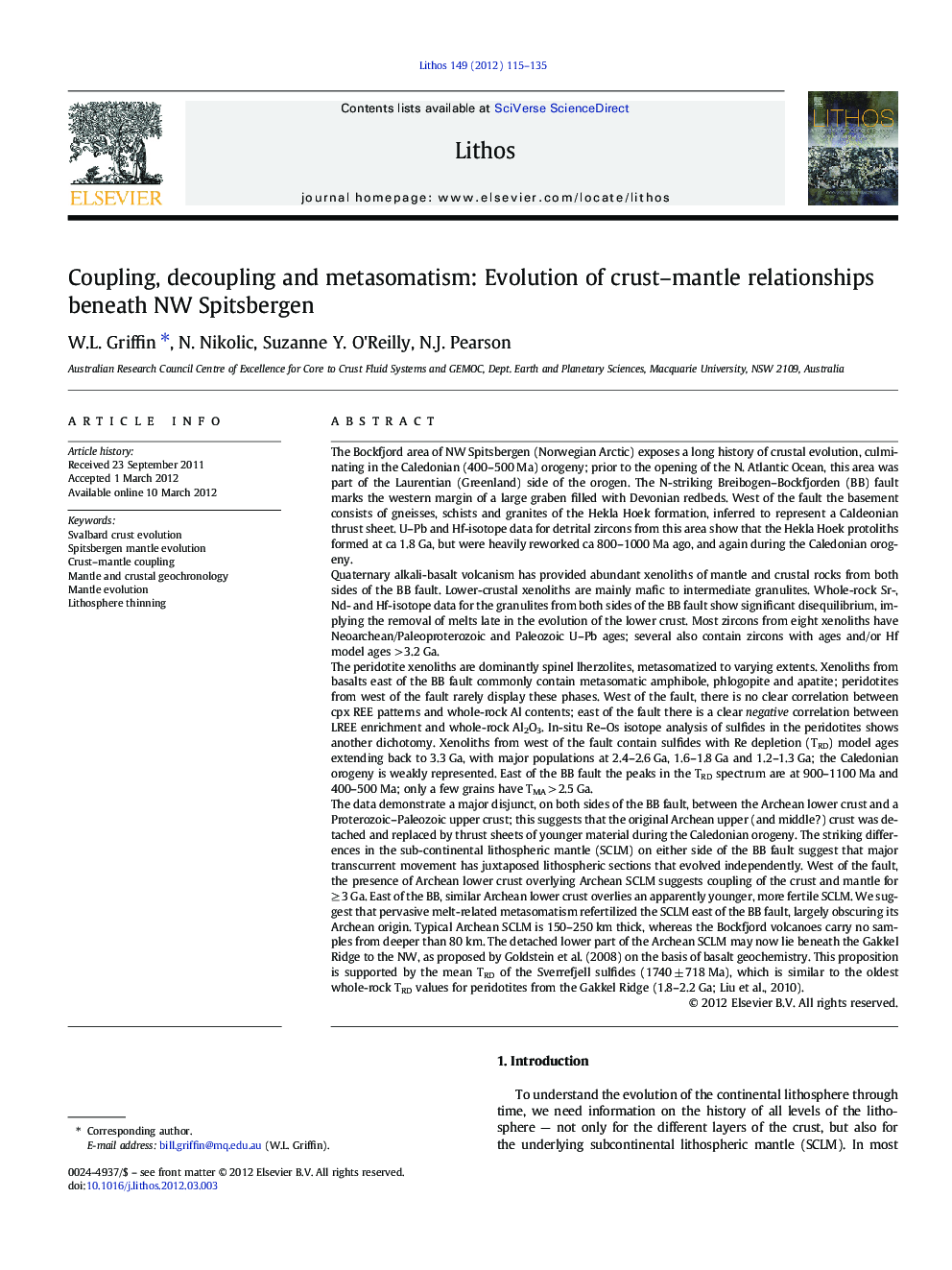| کد مقاله | کد نشریه | سال انتشار | مقاله انگلیسی | نسخه تمام متن |
|---|---|---|---|---|
| 4716582 | 1638704 | 2012 | 21 صفحه PDF | دانلود رایگان |

The Bockfjord area of NW Spitsbergen (Norwegian Arctic) exposes a long history of crustal evolution, culminating in the Caledonian (400–500 Ma) orogeny; prior to the opening of the N. Atlantic Ocean, this area was part of the Laurentian (Greenland) side of the orogen. The N-striking Breibogen–Bockfjorden (BB) fault marks the western margin of a large graben filled with Devonian redbeds. West of the fault the basement consists of gneisses, schists and granites of the Hekla Hoek formation, inferred to represent a Caldeonian thrust sheet. U–Pb and Hf-isotope data for detrital zircons from this area show that the Hekla Hoek protoliths formed at ca 1.8 Ga, but were heavily reworked ca 800–1000 Ma ago, and again during the Caledonian orogeny.Quaternary alkali-basalt volcanism has provided abundant xenoliths of mantle and crustal rocks from both sides of the BB fault. Lower-crustal xenoliths are mainly mafic to intermediate granulites. Whole-rock Sr-, Nd- and Hf-isotope data for the granulites from both sides of the BB fault show significant disequilibrium, implying the removal of melts late in the evolution of the lower crust. Most zircons from eight xenoliths have Neoarchean/Paleoproterozoic and Paleozoic U–Pb ages; several also contain zircons with ages and/or Hf model ages > 3.2 Ga.The peridotite xenoliths are dominantly spinel lherzolites, metasomatized to varying extents. Xenoliths from basalts east of the BB fault commonly contain metasomatic amphibole, phlogopite and apatite; peridotites from west of the fault rarely display these phases. West of the fault, there is no clear correlation between cpx REE patterns and whole-rock Al contents; east of the fault there is a clear negative correlation between LREE enrichment and whole-rock Al2O3. In-situ Re–Os isotope analysis of sulfides in the peridotites shows another dichotomy. Xenoliths from west of the fault contain sulfides with Re depletion (TRD) model ages extending back to 3.3 Ga, with major populations at 2.4–2.6 Ga, 1.6–1.8 Ga and 1.2–1.3 Ga; the Caledonian orogeny is weakly represented. East of the BB fault the peaks in the TRD spectrum are at 900–1100 Ma and 400–500 Ma; only a few grains have TMA > 2.5 Ga.The data demonstrate a major disjunct, on both sides of the BB fault, between the Archean lower crust and a Proterozoic–Paleozoic upper crust; this suggests that the original Archean upper (and middle?) crust was detached and replaced by thrust sheets of younger material during the Caledonian orogeny. The striking differences in the sub-continental lithospheric mantle (SCLM) on either side of the BB fault suggest that major transcurrent movement has juxtaposed lithospheric sections that evolved independently. West of the fault, the presence of Archean lower crust overlying Archean SCLM suggests coupling of the crust and mantle for ≥ 3 Ga. East of the BB, similar Archean lower crust overlies an apparently younger, more fertile SCLM. We suggest that pervasive melt-related metasomatism refertilized the SCLM east of the BB fault, largely obscuring its Archean origin. Typical Archean SCLM is 150–250 km thick, whereas the Bockfjord volcanoes carry no samples from deeper than 80 km. The detached lower part of the Archean SCLM may now lie beneath the Gakkel Ridge to the NW, as proposed by Goldstein et al. (2008) on the basis of basalt geochemistry. This proposition is supported by the mean TRD of the Sverrefjell sulfides (1740 ± 718 Ma), which is similar to the oldest whole-rock TRD values for peridotites from the Gakkel Ridge (1.8–2.2 Ga; Liu et al., 2010).
► Lithosphere rifted from Greenland forms 2 fault-separated terranes in NW Svalbard.
► Both terranes have Archean lower crust, different upper crusts (1.1, 1.7 Ga).
► The west terrane's mantle retains Archean Os ages; the east had ~ 500 Ma modification.
► Mantle roots thinned by transport; remnants under Gakkel Ridge, Yermak Plateau?
► General scenario for thinning of deep mantle roots during rifting and accretion?
Journal: Lithos - Volume 149, 15 September 2012, Pages 115–135